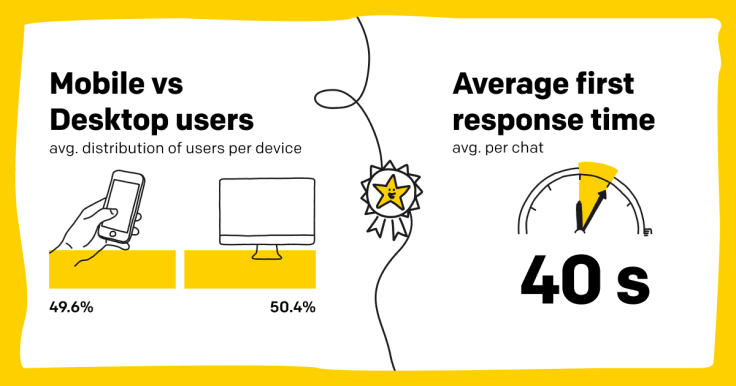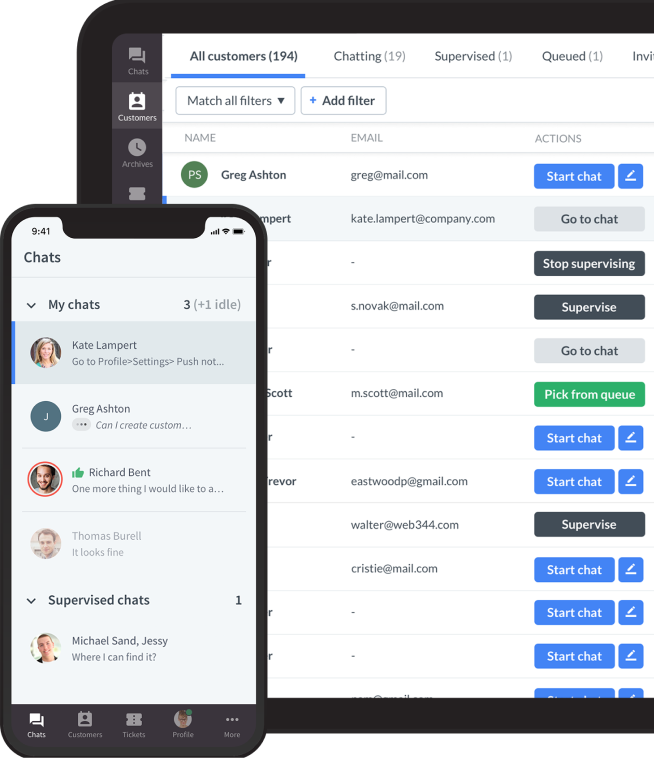
Live chat has quickly become a go-to customer service channel, giving businesses the ability to resolve questions in real time and reducing the delays and frustration often associated with phone or email support.
Companies like Auto Accessories Garage have shown how live chat, when used effectively, can transform service and sales. After implementing live chat, they achieved a 30% increase in conversion rates, by helping customers at key decision points with immediate, personalized support.
Yet live chat isn’t perfect. One of the most common mistakes is bouncing customers between channels. Only 20% of companies resolve customer issues at first contact, often leaving people to repeat their problems across live chat, email, and phone. If you’ve ever been told mid-chat to “please call us instead,” you know how quickly a helpful tool can become a source of frustration.
In this article, I will explore the real live chat advantages and disadvantages, how it compares to other channels like phone support, and what you can do to make live chat an effective part of your customer experience.
Customer experience (cx) and live chat software
Live chat has become a defining feature of modern customer experience, and its influence continues to grow. Businesses that use live chat effectively can dramatically improve customer satisfaction and boost revenue.
Real-time query resolution is at the heart of what makes live chat tools so valuable. Customers no longer tolerate long delays for email replies or extended hold times on the phone. Live chat delivers immediate responses while customers are still engaged.
Providing solutions instantly improves customer satisfaction and keeps frustration levels low, whether it's resolving a login issue, answering product questions, or helping with an order status. A positive, quick resolution often creates loyalty and leaves a lasting impression.
When companies address customer queries through real-time communication of live chat, they frequently see additional business benefits:
- Increased revenue: When you give customers quick answers, it helps remove uncertainty and hesitation, reducing cart abandonment and increasing conversions.
- Improved customer loyalty: Satisfactory live chat experiences can create lasting impressions and encourage repeat business.
- Higher satisfaction scores: Customers feel heard and valued when issues are resolved on the spot.
The impact on revenue from using live chat software is measurable. Businesses that successfully resolve customer queries during live chat interactions frequently report increased sales and conversions. Customers who receive timely, real-time support are more likely to complete their purchase rather than abandon their cart out of frustration or uncertainty. Many companies, including major online retailers, have documented how live chat contributed directly to lifting conversion rates by guiding hesitant customers over the finish line.
Adoption driven by expectations is another powerful reason for the rise of live chat. Customer habits have changed, and immediate access to help is no longer just appreciated, it’s expected. Research shows that customers increasingly prefer live chat over other channels, especially when they expect a response within five minutes or less. This rising demand has pushed live chat to the forefront of customer service strategies across industries, from ecommerce to SaaS and financial services.
Live chat support stands out as a strategic asset because it leverages customer insights. Every live chat conversation generates valuable data that companies can use to improve service and optimize operations. Insights from chat histories, common issues, product inquiries, and feedback help businesses identify customer pain points and anticipate future needs.

Benefits of live chat solution
Live chat solutions offer a powerful blend of flexibility, scalability, and operational efficiency. When implemented strategically, they become more than just a support tool; they become drivers of cost savings and smarter customer engagement. Understanding live chat's advantages and disadvantages is key to maximizing its potential and minimizing its pitfalls.
Unlike phone calls, live chat enables customer service representatives to handle multiple chat conversations simultaneously, increasing efficiency and reducing wait time.
Here’s a deeper look at the core operational and business benefits.
Scalability and multitasking of chat agents
One of the most practical advantages of live chat software is that it allows agents to handle multiple chat conversations at once. While phone agents can only assist one caller at a time, live chat agents can juggle three to six active conversations, depending on complexity and workflow design.
A Forrester report found that companies that adopt live chat experience a 12% improvement in first-contact resolution rates compared to traditional channels. This scalability reduces the number of agents needed to manage high interaction volumes, making cost-effective live chat an efficient way to meet customer demand, especially during peak seasons or product launches.
Practical tip: Train customer service representatives in multitasking best practices and use smart routing rules to ensure that specialized staff prioritize and resolve complex customer issues.
Cost reduction
Live chat is not just convenient for online customers, it also saves businesses money. According to IBM, shifting customer service from phone support to online chat and automated systems can reduce service costs by up to 30%. Phone calls often require longer handling times, more resources, and dedicated infrastructure, while live chat minimizes these requirements.
Additionally, live chat sessions tend to resolve faster. Industry benchmarks show that the average phone call lasts around 6 minutes, while the average live chat interaction takes just 4 minutes. This time saving, multiplied across thousands of interactions, leads to substantial operational savings.
Practical tip: Combine live chat with automated chatbots for handling repetitive inquiries like order status, account questions, or appointment confirmations.
Workflow integration and efficiency
Live chat technology now integrates deeply with CRM platforms, help desk software, and internal knowledge bases, turning agents into highly informed problem-solvers. Agents can view full customer histories, previous conversations, order statuses, and other vital data in real time, eliminating the frustrating need for customers to repeat themselves.
Companies that offer live chat support integration with their CRM and help desk systems can achieve a faster resolution time rate. Additional features such as AI-powered recommendations, canned responses, agent collaboration tools, and file-sharing capabilities enhance consistency and efficiency.
Practical tip: Leverage CRM and help desk integrations to enable agents to switch between chat and ticketing seamlessly.
Proactive customer engagement
Live chat support is unique in that it allows companies to engage multiple customers proactively rather than reactively. According to Kayako, 52% of customers are more likely to make repeat purchases from companies that offer proactive live chat support.
You can set up triggers based on user behavior (e.g., if a customer spends more than 60 seconds on the pricing page or stalls at checkout). A well-timed message like “Hi! Can I help you with any questions before you check out?” can recover a potentially lost sale.
Practical tip: Use behavior-based automation tools to set proactive chat triggers that target visitors based on page activity, cart value, or time on site.
Performance tracking and continuous improvement
Modern live chat platforms include advanced analytics that allows companies to track, measure, and continuously optimize their service delivery. Key performance indicators (KPIs) include average response time, customer satisfaction scores (CSAT), Net Promoter Score (NPS), agent utilization, and first-contact resolution rates.
Data from LiveChat’s Customer Service Report shows that the average first response time for top-performing teams is under 30 seconds. If you consistently monitor agent performance and coach team members based on these metrics, you will see higher satisfaction and stronger brand loyalty.
Practical tip: Establish clear live chat SLAs (service level agreements) and create agent scorecards to regularly review performance, reward top performers, and identify areas for further coaching or process improvement.

Drawbacks and challenges of live chat
While live chat support offers many advantages, it’s not a perfect solution. Poor implementation or lack of planning can create new customer frustrations. You must understand these challenges to use live chat effectively and avoid common mistakes.
Let's go over the main drawbacks.
Lack of visual and verbal cues in live chat support
Unlike phone support, live chat tools rely entirely on written communication, which removes the tone of voice, body language, and other verbal cues that often help clarify meaning in phone or in-person conversations. This can lead to misunderstandings, particularly when dealing with complex or sensitive issues.
For example, a customer asking, “Is this item in stock?” might take a delayed response as disinterest when, in reality, the agent is checking inventory. Similarly, written explanations may not always convey empathy or clarity, leaving customers feeling disconnected.
Tip to avoid it:
Train agents to use friendly, empathetic language and check in if there’s a delay. Phrases like, “Thanks for waiting, I’m just checking that for you now!” keep customers informed and prevent frustration. Also, consider adding typing indicators or automated responses to reassure customers that their query is being handled.
Customer frustration with channel switching
One of the biggest customer frustrations occurs when companies bounce customers between support channels. For example, a customer may start a conversation on live chat only to be told to call phone support or send an email for further assistance. This “contact channel ping-pong” wastes customers’ time and leaves them feeling undervalued.
Research indicates that 62% of customer service channel shifts are considered "high effort," compelling customers to repeat information and navigate multiple platforms to resolve a single issue. Furthermore, 89% of customers express annoyance at having to repeat their issues to multiple agents, highlighting the importance of seamless communication across channels.
Tip to avoid it:
Ensure chat agents have the tools and training to resolve as many queries as possible directly. Implement omnichannel software that allows chat agents to access the customer’s full history and, if escalation is needed, transfer the case seamlessly with full context. Provide clear escalation pathways so the customer stays informed about what will happen next.

Security and privacy concerns
Handling sensitive information over live chat requires robust security protocols. Customers may be reluctant to share personal contact details or payment information in a chat window unless they know the channel is secure and encrypted.
Without proper encryption, authentication, and secure customer data handling practices, businesses risk exposing customers to data breaches or fraud.
Tip to avoid it:
Use end-to-end encryption for all chat communications. Make sure your live chat software complies with global data privacy regulations such as GDPR or CCPA. Provide clear security messages within the chat: “This conversation is protected by industry-standard encryption.” Avoid asking for highly sensitive information like full credit card numbers or social security numbers via chat.
High customer expectations for fast responses
Potential customers expect speed from live chat. A delay of more than a few minutes can cause frustration or even drive customers away. Studies show that many customers expect an agent to respond within five minutes of initiating a chat session.
Staffing live chat adequately to meet these expectations, especially during peak hours, holidays, or across global time zones, can be a major operational challenge. Businesses that fail to deliver timely responses risk damaging customer trust and satisfaction.
Tip to avoid it:
Track live chat metrics such as average response time and chat abandonment rate. Add chatbots for initial triage to answer basic questions (e.g., order tracking, FAQs) and route complex queries to live agents. Adjust staffing levels during known busy periods like sales events or holidays.
Resource-intensive setup and maintenance
Although live chat support can reduce long-term costs, setting up and maintaining an effective live chat program is resource-intensive. It requires not only investing in technology but also hiring and training skilled chat agents, creating workflows, monitoring quality, and integrating live chat into CRM and ticketing systems.
Additionally, maintaining consistency and quality across multiple agents and time zones requires strong management and ongoing performance tracking. Without this, the customer experience can vary widely, undermining the benefits live chat is meant to provide.
Tip to avoid it:
Start with a phased rollout: launch chat during peak business hours first, then expand as your live chat team grows. Use performance dashboards to monitor quality and agent productivity. Regularly update agent scripts and provide ongoing coaching to ensure consistency and high standards across every interaction.
Integrating live chat with other customer support channels
While live chat offers speed and convenience, it rarely works as the only customer support channel. Customers want flexibility, and businesses that combine live chat with email, social media, and phone support often deliver a more satisfying overall experience.
Integrating live chat support with other service channels also prevents customers from being bounced around or having to repeat themselves, which is one of the top frustrations in customer service.
The table below outlines the key areas of live chat integration, with examples and practical tips on how businesses can successfully blend live chat into a seamless, omnichannel customer support strategy.
| Key aspect | Description | Example | Tip |
| Balancing live chat services and phone support | Live chat can handle high volumes of simple queries, while phone support is better for complex or emotional cases. | A travel agency uses live chat for booking changes but offers phone support for urgent cancellations. | Train agents to recognize when to escalate chats to phone support to avoid customer frustration. |
| Seamless integration into support inboxes | Live chat should be part of a unified system where all customer interactions are visible in one place. | A SaaS company integrates chat, email, and Facebook messenger into a single CRM dashboard. | Use omnichannel helpdesk tools to ensure agents have full context across channels. |
| Recognizing the strengths of phone support | Some customers still prefer phone conversations for sensitive or complex issues. | An insurance company offers phone support for policy changes while keeping chat available for general customer inquiries. | Always provide an easy and clear way to escalate chat conversations to a live phone agent if needed. |
| Adopting an omnichannel approach | Businesses should offer multiple communication options to match customer preferences. | A retail brand offers flexible support options through live chat, phone, email, and social media DMs. | Survey customers regularly to understand which channels they prefer and adapt accordingly. |
| Streamlining service delivery | Integrating chat with other channels prevents customers from having to repeat information. | A bank uses live chat for initial troubleshooting and seamlessly transfers complex cases to account specialists by phone. | Equip service agents with a unified customer history view to eliminate repetitive explanations by the customer. |
Future of online support: live chat advantages and disadvantages
Live chat has evolved from a convenient add-on to a critical component of modern customer service. When implemented thoughtfully, it ensures immediate assistance, drives loyalty through personalization, and offers valuable insights that help you continuously refine your service strategies.
However, live chat is not without challenges. Understanding the full scope of live chat advantages and disadvantages is essential to avoid poor response times, miscommunication, and security concerns, which can quickly turn a positive customer interaction into a negative one.
Looking ahead, the future of live chat software is closely tied to emerging technologies. AI-powered chatbots and machine learning-driven assistance will help companies manage increasing volumes without compromising quality.
Natural language processing and predictive analytics will allow for even more proactive support with a personal touch. We can also expect more businesses to adopt truly omnichannel customer service platforms where live chat, phone, email, social media, and messaging apps work together in a unified experience.
If you’re ready to explore how live chat can elevate your customer experience, discover the powerful features and capabilities of LiveChat to start building a faster, smarter, and more connected customer support strategy today.




